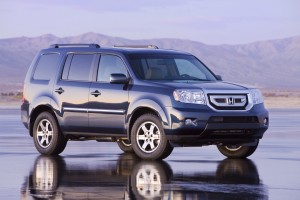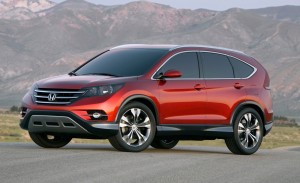How much money will I save buying a more fuel-efficient car? This seems like a common question when in the midst of purchasing a car, yet this question is more interesting mathematically than meets the eye.
A few weeks ago, my husband John and I were debating between buying a Honda Pilot and a Honda CR-V. John was pulling for the more powerful Pilot (on the left) while I was leaning towards the smaller CR-V (on the right).
While I was test driving the CR-V, my husband asked the car salesman how the gas mileages of the two cars compared . We were informed that the CR-V’s gas mileage is 22 miles per gallon (mpg) for city driving and 30 mpg for highway driving; the Pilot is 17 city and 24 highway. Then we proceeded to figure out how much money would we save if we bought a CR-V. Since we were buying a car for me and I drive about 75% of my miles on city roads, we estimated that the average gas mileage for a CR-V is about 24 mpg and Pilot is about 19 mpg. An explanation on how to precisely compute the average gas mileage given the city and highway mileage and percent of miles driven on each type is given here.
At this point, things got interesting. I was test-driving an unfamiliar car so that my math wheels were not spinning properly during this mathematical conversation. In the meanwhile, both John and the car salesman insisted that since the CR-V’s gas mileage is 5 less than the Pilot’s gas mileage, that 5 mpg difference, in addition to the number of miles driven in a year and cost of gasoline are the only numbers needed to calculate the difference in annual gas costs between the two cars.
This conclusion didn’t feel right to me, but I didn’t have the mathematical justification at hand since my hands were busy steering a car that did not belong to me. So once I had a paper and pencil in hand, I started working out the problem. If you have a minute, I invite you to work it out as well.
Suppose we drive 12,000 miles per year and car A uses x miles per gallon and car B uses (x+5) miles per gallon. Then car A uses [12,000/x] gallons per year while car B uses [12,000/(x+5)] gallons per year. Thus, the annual cost of gas for car A, y, is calculated as y = [($/gallon)*(12,000/x) gallons] dollars while the annual gas cost for car B, z, is z = {($/gallon)*[12,000/(x+5)] gallons} dollars. When you simplify difference in costs, (y-z), in terms of x, the result is ($/gallon)*12000*5/(x^2+5x) or:
[($/gallon)(number of miles driven in a year)(5)]/(x^2+ 5x) dollars.
Examining this algebraic expression, we see that the difference in costs not only depends on the difference in gas mileages, but also on the gas mileages of the 2 cars. The higher the gas mileage of the 2 cars, the less the savings are between the 2 cars, even if the difference in gas mileage remains 5!
Driving a CR-V instead of a Pilot would save us about $500 this year assuming that I drive 12,000 miles this year. However, if we had been choosing between a Toyota Prius (about 49 mpg) and a Honda Civic Hybrid (about 44 mpg), we would have saved only about $100 per year with the same parameters even though the difference in gas mileage is about 5 mpg.
You can calculate the savings per year at the following website: http://www.fueleconomy.gov/feg/findacar.shtml However, you don’t truly appreciate the mathematical relationship until you’ve worked out the algebraic expressions.
Conclusion: My husband and I ended up buying the CR-V because as our car salesman wisely reminded us, “Happy wife, happy life.”

Coming next: Creating a program that will calculate the gas savings choosing a more fuel-efficient car.



